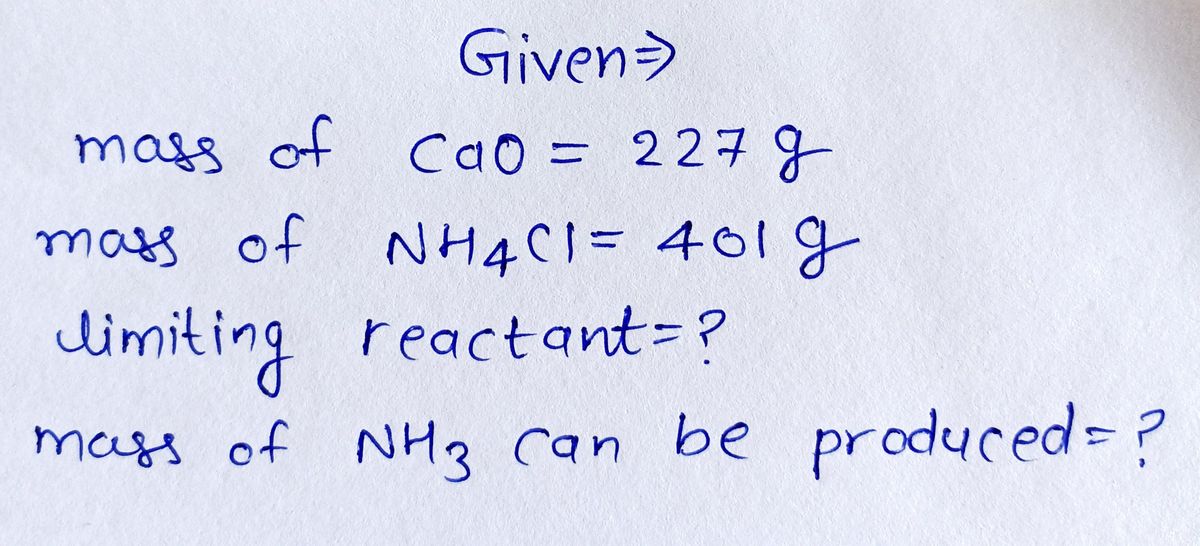Ammonia gas can be prepared by the reaction of a metal oxide such as calcium oxide with ammonium chloride. CaO (s) + 2 NH4Cl(s) → 2 NH3(g) + H₂O(g) + CaCl₂ (s) If 227 g of CaO and 401 g of NH4Cl are mixed, what is the limiting reactant? What mass of NH3 can be ploduced? g
Ammonia gas can be prepared by the reaction of a metal oxide such as calcium oxide with ammonium chloride. CaO (s) + 2 NH4Cl(s) → 2 NH3(g) + H₂O(g) + CaCl₂ (s) If 227 g of CaO and 401 g of NH4Cl are mixed, what is the limiting reactant? What mass of NH3 can be ploduced? g
Chemistry
10th Edition
ISBN:9781305957404
Author:Steven S. Zumdahl, Susan A. Zumdahl, Donald J. DeCoste
Publisher:Steven S. Zumdahl, Susan A. Zumdahl, Donald J. DeCoste
Chapter1: Chemical Foundations
Section: Chapter Questions
Problem 1RQ: Define and explain the differences between the following terms. a. law and theory b. theory and...
Related questions
Question
![### Chapter 4 - Stoichiometry: Quantitative Information
#### Ammonia Gas Preparation
Ammonia gas can be prepared by the reaction of a metal oxide, such as calcium oxide, with ammonium chloride:
\[ \text{CaO(s)} + 2 \text{NH}_4\text{Cl(s)} \rightarrow 2 \text{NH}_3\text{(g)} + \text{H}_2\text{O(g)} + \text{CaCl}_2\text{(s)} \]
#### Problem Statement
If 227 g of CaO and 401 g of NH₄Cl are mixed, determine the following:
1. **Limiting Reactant:** Identify the reactant that will be completely consumed and limit the amount of product formed.
*Input box for the answer*
2. **Mass of NH₃ Produced:** Calculate the mass of ammonia (\(\text{NH}_3\)) that can be produced in the reaction.
*Input box for the result in grams*](/v2/_next/image?url=https%3A%2F%2Fcontent.bartleby.com%2Fqna-images%2Fquestion%2Ff7ba9c54-af2b-48c5-8dd4-4f214c676725%2F6d4441a9-4549-442d-ae84-37df2619f640%2F843n124_processed.jpeg&w=3840&q=75)
Transcribed Image Text:### Chapter 4 - Stoichiometry: Quantitative Information
#### Ammonia Gas Preparation
Ammonia gas can be prepared by the reaction of a metal oxide, such as calcium oxide, with ammonium chloride:
\[ \text{CaO(s)} + 2 \text{NH}_4\text{Cl(s)} \rightarrow 2 \text{NH}_3\text{(g)} + \text{H}_2\text{O(g)} + \text{CaCl}_2\text{(s)} \]
#### Problem Statement
If 227 g of CaO and 401 g of NH₄Cl are mixed, determine the following:
1. **Limiting Reactant:** Identify the reactant that will be completely consumed and limit the amount of product formed.
*Input box for the answer*
2. **Mass of NH₃ Produced:** Calculate the mass of ammonia (\(\text{NH}_3\)) that can be produced in the reaction.
*Input box for the result in grams*
Expert Solution
Step 1

Step by step
Solved in 3 steps with 3 images

Knowledge Booster
Learn more about
Need a deep-dive on the concept behind this application? Look no further. Learn more about this topic, chemistry and related others by exploring similar questions and additional content below.Recommended textbooks for you

Chemistry
Chemistry
ISBN:
9781305957404
Author:
Steven S. Zumdahl, Susan A. Zumdahl, Donald J. DeCoste
Publisher:
Cengage Learning

Chemistry
Chemistry
ISBN:
9781259911156
Author:
Raymond Chang Dr., Jason Overby Professor
Publisher:
McGraw-Hill Education

Principles of Instrumental Analysis
Chemistry
ISBN:
9781305577213
Author:
Douglas A. Skoog, F. James Holler, Stanley R. Crouch
Publisher:
Cengage Learning

Chemistry
Chemistry
ISBN:
9781305957404
Author:
Steven S. Zumdahl, Susan A. Zumdahl, Donald J. DeCoste
Publisher:
Cengage Learning

Chemistry
Chemistry
ISBN:
9781259911156
Author:
Raymond Chang Dr., Jason Overby Professor
Publisher:
McGraw-Hill Education

Principles of Instrumental Analysis
Chemistry
ISBN:
9781305577213
Author:
Douglas A. Skoog, F. James Holler, Stanley R. Crouch
Publisher:
Cengage Learning

Organic Chemistry
Chemistry
ISBN:
9780078021558
Author:
Janice Gorzynski Smith Dr.
Publisher:
McGraw-Hill Education

Chemistry: Principles and Reactions
Chemistry
ISBN:
9781305079373
Author:
William L. Masterton, Cecile N. Hurley
Publisher:
Cengage Learning

Elementary Principles of Chemical Processes, Bind…
Chemistry
ISBN:
9781118431221
Author:
Richard M. Felder, Ronald W. Rousseau, Lisa G. Bullard
Publisher:
WILEY